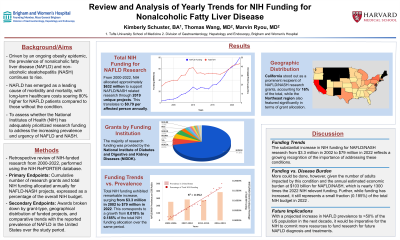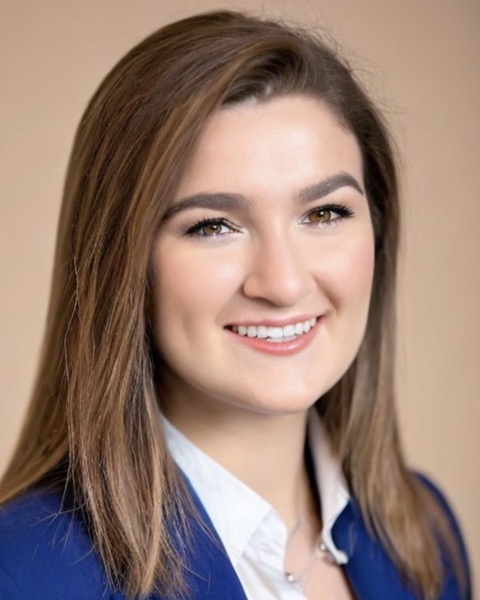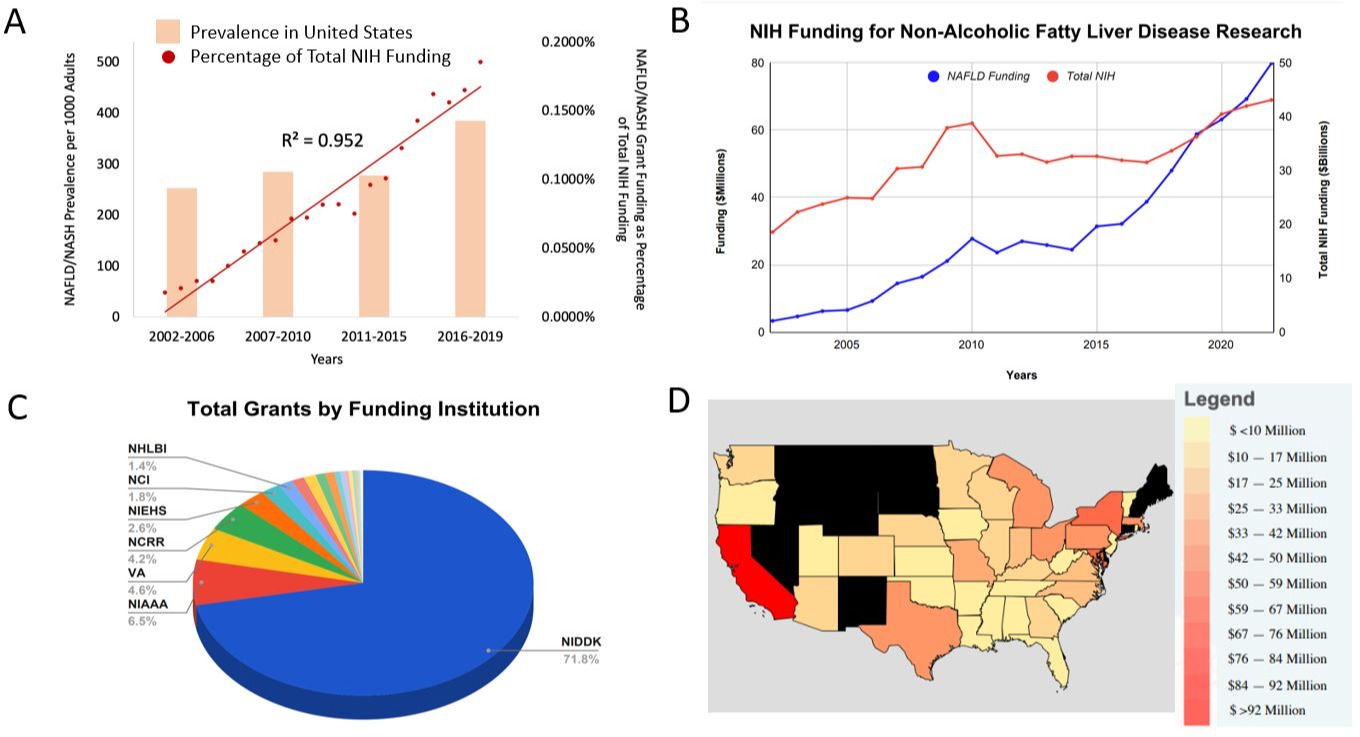Tuesday Poster Session
Category: Liver
P3859 - Review and Analysis of Yearly Trends for NIH Funding for Nonalcoholic Fatty Liver Disease
Tuesday, October 24, 2023
10:30 AM - 4:00 PM PT
Location: Exhibit Hall

Has Audio

Kimberly Schuster, BA
Tufts University School of Medicine
Boston, MA
Presenting Author(s)
Kimberly Schuster, BA1, Thomas J. Wang, MD2, Marvin Ryou, MD3
1Tufts University School of Medicine, Boston, MA; 2Brigham and Women's Hospital, Boston, MA; 3Brigham and Women's Hospital, Boston, MA
Introduction: Driven by an ongoing obesity epidemic, the prevalence of nonalcoholic fatty liver disease (NAFLD) and non-alcoholic steatohepatitis (NASH) continues to increase in the United States. NAFLD has become a leading cause of morbidity and mortality, and long-term cumulative healthcare costs are 80% higher for NAFLD patients than those without NAFLD. However, it is unclear whether research funding from the National Institutes of Health (NIH) has prioritized NAFLD-related research in response to this increasing prevalence and urgency. We aimed to evaluate the recent trends in NIH-funded NAFLD/NASH research and assess the field’s historic and current funding landscape.
Methods: A retrospective review of NAFLD/NASH funding on NIH study sections was performed using the NIH Research Portfolio Online Reporting Tools Expenditures and Results (RePORTER) over a study period of 20 years: 2002-2022. Primary endpoints included the cumulative number of grants and NIH funding per year as a percentage of total NIH funding. Secondary endpoints included awards broken down by grant-type and location, as well as trend comparison with reported NAFLD prevalence in the United States over the study period.
Results: Since 2002, the NIH has funded ~$632 million of NAFLD/NASH-related research through 2019 unique projects. The total NIH funding for NAFLD-related projects has increased from $3.3 million in 2002 to $79 million in 2022, or 0.018% of total NIH funding in 2002 to 0.185% in 2022 [Figures 1A and 1B]. With a total of ~100 million affected US adult population based on most recent prevalence estimates, the funding comes out to ~$0.79 per affected person per year in NIH funding. Most funding came from the National Institute of Diabetes and Digestive and Kidney Diseases (NIDDK) [Figure 1C]. Geographically, the majority of grands were received in California (16%) and the Northeast region [Figure 1D].
Discussion: The NIH is the largest public funder of biomedical research and has a strong track record of funding NAFLD/NASH research. More could be done however given the number of adults impacted by this condition and the estimated annual economic burden at $103 billion for NAFLD/NASH, which is nearly 1300 times the 2022 NIH relevant funding. With a projected increase in NAFLD prevalence to >50% of the US population in the next decade, the NIH should consider committing more resources to fund research for future NAFLD diagnosis and treatments.

Disclosures:
Kimberly Schuster, BA1, Thomas J. Wang, MD2, Marvin Ryou, MD3. P3859 - Review and Analysis of Yearly Trends for NIH Funding for Nonalcoholic Fatty Liver Disease, ACG 2023 Annual Scientific Meeting Abstracts. Vancouver, BC, Canada: American College of Gastroenterology.
1Tufts University School of Medicine, Boston, MA; 2Brigham and Women's Hospital, Boston, MA; 3Brigham and Women's Hospital, Boston, MA
Introduction: Driven by an ongoing obesity epidemic, the prevalence of nonalcoholic fatty liver disease (NAFLD) and non-alcoholic steatohepatitis (NASH) continues to increase in the United States. NAFLD has become a leading cause of morbidity and mortality, and long-term cumulative healthcare costs are 80% higher for NAFLD patients than those without NAFLD. However, it is unclear whether research funding from the National Institutes of Health (NIH) has prioritized NAFLD-related research in response to this increasing prevalence and urgency. We aimed to evaluate the recent trends in NIH-funded NAFLD/NASH research and assess the field’s historic and current funding landscape.
Methods: A retrospective review of NAFLD/NASH funding on NIH study sections was performed using the NIH Research Portfolio Online Reporting Tools Expenditures and Results (RePORTER) over a study period of 20 years: 2002-2022. Primary endpoints included the cumulative number of grants and NIH funding per year as a percentage of total NIH funding. Secondary endpoints included awards broken down by grant-type and location, as well as trend comparison with reported NAFLD prevalence in the United States over the study period.
Results: Since 2002, the NIH has funded ~$632 million of NAFLD/NASH-related research through 2019 unique projects. The total NIH funding for NAFLD-related projects has increased from $3.3 million in 2002 to $79 million in 2022, or 0.018% of total NIH funding in 2002 to 0.185% in 2022 [Figures 1A and 1B]. With a total of ~100 million affected US adult population based on most recent prevalence estimates, the funding comes out to ~$0.79 per affected person per year in NIH funding. Most funding came from the National Institute of Diabetes and Digestive and Kidney Diseases (NIDDK) [Figure 1C]. Geographically, the majority of grands were received in California (16%) and the Northeast region [Figure 1D].
Discussion: The NIH is the largest public funder of biomedical research and has a strong track record of funding NAFLD/NASH research. More could be done however given the number of adults impacted by this condition and the estimated annual economic burden at $103 billion for NAFLD/NASH, which is nearly 1300 times the 2022 NIH relevant funding. With a projected increase in NAFLD prevalence to >50% of the US population in the next decade, the NIH should consider committing more resources to fund research for future NAFLD diagnosis and treatments.

Figure: Figure 1
Disclosures:
Kimberly Schuster indicated no relevant financial relationships.
Thomas Wang indicated no relevant financial relationships.
Marvin Ryou: Boston Scientific – Consultant. Cook – Consultant. EnteraSense – Consultant. Fuji – Consultant. GI Windows – Consultant. Medtronic – Consultant. Olympus – Consultant.
Kimberly Schuster, BA1, Thomas J. Wang, MD2, Marvin Ryou, MD3. P3859 - Review and Analysis of Yearly Trends for NIH Funding for Nonalcoholic Fatty Liver Disease, ACG 2023 Annual Scientific Meeting Abstracts. Vancouver, BC, Canada: American College of Gastroenterology.
